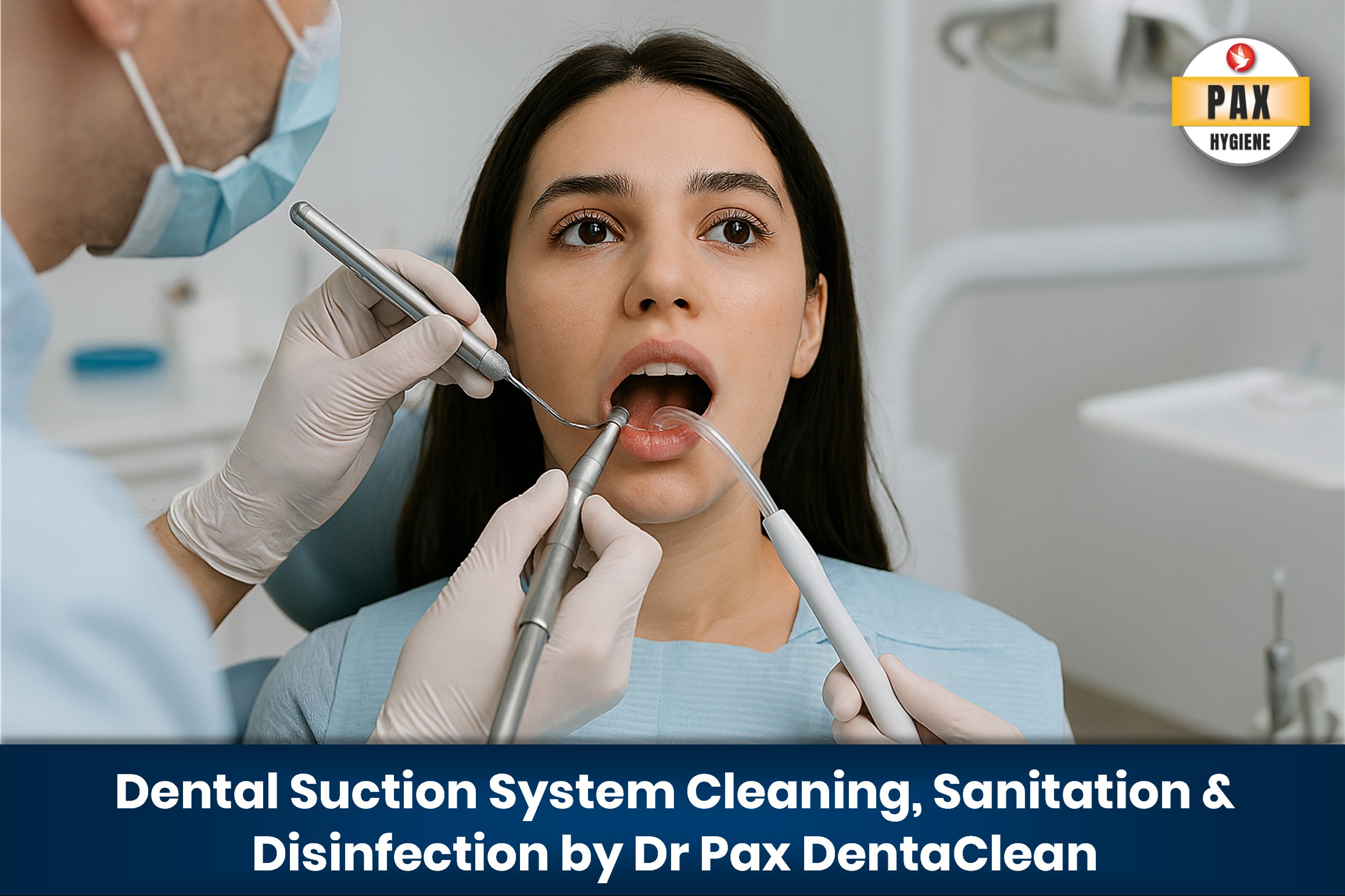top of page
Dental Suction System Cleaning, Sanitation & Disinfection by Dr Pax DentaClean

Problems:
Dental suction systems and aspirators represent the most challenging infection control components in modern dental practices, with research demonstrating that 60-70% of aspiration systems harbor dangerous biofilm contamination including Legionella pneumophila, Pseudomonas aeruginosa, and multidrug-resistant bacterial species. These complex networks of tubing, separators, and vacuum chambers create ideal environments for pathogenic microorganisms that multiply rapidly in warm, moist conditions while remaining protected from conventional cleaning approaches.
The clinical implications extend far beyond equipment performance as contaminated suction systems actively generate infectious aerosols during patient procedures, creating significant cross-contamination risks for both patients and clinical staff. Biofilm accumulation progressively reduces aspiration efficiency, generates persistent odors that compromise patient comfort, and creates breeding grounds for antibiotic-resistant pathogens that can trigger serious respiratory infections, particularly in immunocompromised patients undergoing complex dental procedures.
Traditional maintenance approaches prove inadequate for comprehensive aspirator hygiene as weekly or irregular cleaning protocols allow biofilm maturation while harsh acid-based or foaming cleaners cause progressive corrosion damage to expensive tubing systems, separator mechanisms, and vacuum seals. Many practices resort to improvised cleaning methods using household bleach or phenyl-based solutions that lack validated antimicrobial efficacy while potentially damaging sensitive system components, ultimately creating more problems than they resolve.
The economic burden compounds these safety concerns as contaminated aspiration systems experience accelerated component failure, reduced operational efficiency, increased service calls, and premature replacement requirements that significantly impact practice profitability. Rural practices face particular challenges accessing appropriate suction system cleaners, while high-volume urban clinics struggle with time constraints that prevent thorough daily maintenance, creating systemic infection control vulnerabilities that compromise professional standards and patient safety protocols.
Solution:
Dr Pax DentaClean is a 5th generation QAC-based, GLP-validated, aldehyde-free solution specifically engineered for comprehensive suction system and aspirator hygiene.
Standards Compliance: Validated under ASTM E2315, EN 13727, AOAC 964.02.
GLP Validation: Achieves 99.999% microbial kill in aspiration systems with 60-minute contact at 30ml/L dilution, including biofilm elimination.
System Safety: Non-foaming, non-corrosive formulation safe for tubing, separators, seals, and all major suction system brands and configurations.
Flexibility: Routine (60 min) or overnight (comprehensive) protocols accommodate different cleaning schedules and contamination levels.
How to Use:
Pre-Treatment Protocol:
Flush the aspiration system thoroughly with cold water to remove coarse debris, organic matter, and loose biofilm material before disinfection treatment.
Solution Preparation:
Prepare working solution using 30ml Dr Pax DentaClean concentrate per 1L clean water directly in the suction holding container or dedicated mixing vessel.
Application Process:
Aspirate the prepared solution through all suction lines, separator units, and vacuum chambers using the system's normal operation cycle. Ensure complete filling of all tubing networks and internal components with disinfectant solution.
Contact Time Protocols:
For routine daily disinfection, allow solution to remain in the aspiration system for 60 minutes minimum. For comprehensive weekly or monthly disinfection, leave solution in system overnight for 8-12 hours to achieve maximum biofilm penetration and pathogen elimination.
Post-Treatment Flushing:
After required contact time, flush the entire system with approximately 2L of cold clean water to remove all disinfectant residues and loosened biofilm material.
Verification Testing:
Run suction briefly to confirm normal flow rates, absence of chemical residues, and elimination of odors indicating successful biofilm removal and system sanitization.
Enhanced Protocol for Problem Systems:
For heavily contaminated or underperforming aspirators, use 60ml concentrate per 1L water and extend contact time to 2-4 hours before comprehensive flushing and verification.
Product Benefits:
(1) GLP-certified efficacy against biofilm and waterborne pathogens in aspiration systems
(2) Flexible protocols: 60 minutes routine or overnight comprehensive disinfection
(3) Non-foaming, aldehyde-free, chlorine-free formulation prevents system damage
(4) Compatible with all suction system types including wet, dry, and combination units
(5) Reduces equipment failure rates, improves efficiency, and lowers service costs
Competitive Landscape:
The dental aspiration system cleaning market includes several established products, each presenting distinct limitations for comprehensive suction system maintenance.
Dürr Orotol Plus provides clinically validated efficacy but relies on costly international imports, making routine use prohibitively expensive for most dental practices while creating supply chain vulnerabilities.
Prime Dental Biofilm-X utilizes enzyme-based cleaning technology that requires multiple sequential treatment steps, significantly increasing time investment and creating opportunities for procedural errors during complex protocols.
Alprojet-W offers limited penetration capabilities for established biofilm removal while requiring higher dilution concentrations that increase per-use costs and reduce cost-effectiveness for daily maintenance.
Traditional phenyl-based cleaners commonly used throughout dental practices provide insufficient antimicrobial coverage against resistant pathogens while causing progressive deterioration of rubber tubing components and vacuum seals.
Dr Pax DentaClean addresses these market limitations by delivering a simpler, safer, and more cost-effective single-step protocol that matches international efficacy standards while ensuring consistent domestic availability and competitive pricing structures.
The mention of third-party brands is for comparative context only. Pax Hygiene Pvt. Ltd. makes no representation regarding the accuracy or completeness of competitor claims, and no disparagement is intended. Healthcare professionals should evaluate all products independently and in accordance with manufacturer instructions before use.
Professional Standards and Alignment:
Dr Pax DentaClean supports Dental Council of India, WHO, and CDC waterline hygiene protocols while ensuring compliance with quality audits and medico-legal safety standards for aspiration system maintenance.
Dr Pax DentaClean provides specialized solutions across all dental facility applications. Each dedicated guide contains detailed protocols, professional techniques, and application-specific dilution ratios validated for optimal results:
(1) How to Achieve Professional Hard Surface Deep Disinfection & Biofilm Removal with Dr Pax DentaClean.
(2) How to Prepare DIY Disinfectant Spray & ULV Application Solutions with Dr Pax DentaClean.
(3) How to Perform Terminal Disinfection & ULV Fogging for Comprehensive Dental Facility Sanitation.
(4) How to Execute Pre-Sterilization Instrument Cleaning & Biofilm Elimination for Dental Equipment.
(5) How to Disinfect Impression Materials While Preserving Dimensional Stability with Professional-Grade Solutions.
(6) How to Deep Clean Dentures & Prosthetics with Anti-Biofilm Technology for PMMA & Thermoplastic Materials.
(7) How to Deep Clean Spittoons, Cuspidors & Drain Systems with Deodorizing & Anti-Biofilm Action.
VISIT DR PAX DENTACLEAN PRODUCT PAGE
bottom of page